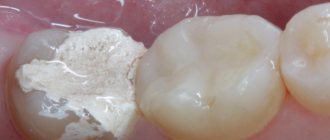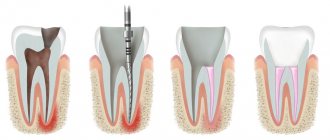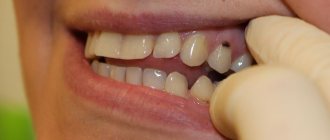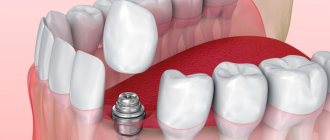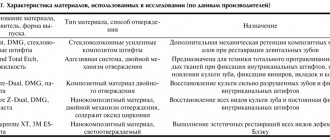Tooth enamel is the hardest tissue in the human body. Up to 90% of calcium reserves are concentrated here. However, cosmetic dentistry regularly deals with defects in this tissue. The fact is that hardness and ductility are different things. With impressive hardness levels, enamel is a fragile material that easily chips and cracks.
The situation gets worse if the enamel is weak. Temperature changes, chronic diseases, blows - and then the tooth breaks off. The situation is unpleasant, and in the long term it is also fraught with caries. Through the crack, bacteria penetrate directly into the tooth, to the pulp, which means that caries will quickly develop into pulpitis. In general, a chipped tooth is a reason to see a doctor, and quickly.
So, what to do if a tooth chips?
- Rinse your mouth with any suitable antiseptic or water to protect the tooth from bacteria and food debris.
- If there is bleeding, apply a tampon with hydrogen peroxide or a hemostatic sponge.
- Apply cold externally to prevent swelling from developing.
- If the pain is very severe, take a pain reliever.
- If a tooth chips on the street, try to rinse your mouth with drinking water (mineral water is also suitable, but not sugary drinks). Other measures can be postponed to your home or the nearest pharmacy.
After that, call your dentist. There is no point in going to emergency rooms - they will simply pull out the affected tooth, especially if a child’s baby tooth has chipped off. You need to eliminate the defect without unnecessary sacrifices.
Fortunately, there are ways to quickly restore a tooth, even if it is severely damaged. There is a whole direction - aesthetic restoration of teeth, it deals with both acquired and congenital defects. Today, restorative dentists work wonders to transform small and uneven teeth into a Hollywood smile. This direction is developed both in pediatric and adult dentistry.
Differences between a chipped tooth and other types of damage
In dentistry, a chipped tooth is any type of mechanical damage leading to disruption of the anatomy and structure of tissues. Experts have different interpretations of this concept. For example, you can find diagnoses such as “chipped the tooth wall below the gum level” or “chipped the tooth wall under the gum.” However, in the classical sense, this is damage to the coronal part (in other words, a chipped tooth crown). Trauma does not imply its loss or change in position relative to the jaw and damage to the ligamentous apparatus. You should also distinguish between chips and root fractures, since in the second case the damage affects the root part. In this case, combined injuries also occur, when, for example, a chip of the crown part and tooth dislocation are diagnosed at the same time.
Example 3. Chronic periodontitis, significant root exposure, tooth mobility
If chronic periodontitis (periodontal disease) is accompanied by significant loss of bone tissue (more than ½ of the root length), tooth mobility, and exposure of root bifurcations, tooth extraction is the only possible solution to the problem.
In the case of periodontal disease, the main problem is the presence of periodontal pockets and loss (atrophy) of the bone tissue around the teeth. The roots are gradually exposed, and tooth mobility appears. If the periodontal pockets are so deep that even periodontal surgery cannot solve the situation, it is necessary to remove such teeth, because Millions of microbes accumulate in the pockets, which further “corrode” the bone. It is better not to wait until the teeth fall out on their own, but to remove the source of infection, thereby preventing further loss of bone tissue and leaving the possibility of implantation.
Causes
- Dental trauma. Falls and impacts are the main reason why chips and cracks occur in perfectly healthy teeth;
- Negligence towards one’s health and bad habits (opening beer bottles with teeth, cracking hard nuts with them, gnawing hard objects, etc.);
- Demineralization of tooth enamel. A process that leads to weakening of enamel and increased risk of injury;
- Carious lesions. They damage the structure of enamel and dentin and thereby make the tooth more vulnerable to mechanical stress. Depulpation completely “kills” the tooth: the tissues, not receiving nutrition from the pulp, become very fragile;
- Bite abnormalities. Cause improper load distribution, which increases pressure on individual teeth or areas of the dentition;
- Incorrect filling. Due to an incorrectly installed filling, the chewing tooth often chips;
- Poor nutrition and poor hygiene. An indirect cause that affects dental health in general;
- Weakened immunity, bad genetics.
Restoration of chewing teeth
If a piece of a chewing tooth breaks off, the same methods are used to restore it or restore it as for the front ones, with the exception of veneers and lumineers.
However, there are some distinctive features of recovery. Ample opportunities are provided by the absence of the need for impeccable aesthetics - these teeth are invisible when smiling and talking. Particular attention is paid to the strength and functionality of the tooth. What methods are used for recovery?
- Restoration with composites. Chipped chewing teeth can be restored using composite filling materials. However, minor damage can simply grind off: the doctor will remove the sharp edges so that the soft tissues are not injured.
- Restoration with ceramic inlays. If the chip extends to the chewing part, ceramic inlays are used. Their installation allows you to perfectly restore the shape of the tooth, since the inlay is made in advance in a dental laboratory according to the impression and exact parameters of the patient’s tooth.
- Crowns/bridges. For severe damage involving dentin and pulp, crowns and bridges may be useful.
- Implantation. The most reliable way to restore the root and crown of a tooth.
It is worth noting that wisdom teeth or “eights” are restored extremely rarely - only if they are involved in the chewing process, are needed for symmetry during orthodontic treatment, or are potentially useful as a support for installing dentures. There is practically no load on them, so restoring them is most often simply not advisable.
Classification of chips
| Types of chips | Description |
| Chip of tooth enamel | The easiest type of chipping, in which only the enamel structure is damaged. These could be cracks or a small chip in the tooth. There is no pain, but lack of treatment can worsen the situation. In addition, even a small chip on a tooth has a negative impact on aesthetics. |
| Dentin chip | As a result of mechanical stress, the dentin layer is damaged. The most common types of such injuries are chipped tooth walls on molars and chipped front teeth. In addition, untreated chips and cracks in the enamel can subsequently worsen and reach the pulp. |
| Severe chipped tooth | These are serious cracks and fractures that significantly damage the crown part of the tooth. Sometimes a tooth splits, when it seems to split into two parts, which severely injures the pulp and dentin. Such chips require long and complex treatment. |
Restoring a chipped tooth
Most patients after mechanical damage have a logical question: how to fix a chipped tooth? The treatment method for chipped teeth depends entirely on the type and degree of damage. Today, technology makes it possible to restore a chipped tooth of almost any severity, but this requires resorting to complex and expensive therapeutic and orthopedic procedures.
| Problem | Description of methods |
| Light chips and cracks (treatment of chipped tooth enamel) | For minor enamel cracks, mineralization and fluoridation are used to restore its protective functions and prevent the cracks from deepening. For minor damage, filling is usually not required. If there is no risk to functionality and aesthetics, then the doctor suggests grinding down the chipped tooth. |
| Moderate chips | If the damage has affected the dentin, then filling is no longer possible. The same can be said about severe chips and cracks in the enamel. Often, chipped teeth are built up with composite materials and restored with inlays. |
| Heavy enamel chips. | If the pulp has been affected, then before starting to restore the chipped tooth, it is necessary to carry out endodontic treatment with removal of the pulp and filling of the canals. In case of chips under the gum and deep clefts of the tooth, its complete or partial removal with subsequent installation of a crown or implant may be indicated. In situations where a large part of the tooth is missing, installing veneers and inlays is almost impossible. |
Prevention
To minimize the likelihood of chips and other mechanical damage, dentists recommend following the following rules:
- monitor oral hygiene, brush your teeth twice a day, use mouthwash and dental floss;
- limit consumption of sweets;
- eat right, eat foods rich in calcium, fluorine, phosphorus, vitamin C;
- stop smoking;
- Regularly (at least twice a year) undergo a preventive examination with a dentist.
You can find out the cost of restoring a chipped tooth and make an appointment with a dentist right now by filling out a simple online form on the website or calling the specified phone numbers.
Chipped front tooth
The chips on the front ones need to be mentioned separately, since the treatment here is aimed at restoring aesthetics. A small chip on a front tooth can be corrected with grinding. In case of noticeable chips of enamel and dentin, the chipped front tooth is built up using filling materials or veneers are installed. For more severe damage, crowns are installed. Usually these are products made of ceramics or zirconium, since metal ceramics are less aesthetically pleasing and can oxidize. If a tooth has chipped under the gum or has split into two halves, most often the patient is offered removal and installation of an implant. Restoration requires the use of a certain type of filling that meets high aesthetic requirements. Most often, photopolymer or compomer fillings are used to treat a chipped front tooth.
Artistic extension
Artistic restoration is a method in which chips are restored using various restoration materials (we are talking about composites - they are also used for classic tooth filling). They allow you to replicate the shape, color and transparency of a natural tooth.
Such restoration is carried out directly in the patient’s mouth - using polymers or composites, the doctor restores the integrity of the tooth, literally building it up. The advantage of the technology is speed (they came to the doctor and left with new teeth), as well as the price. The cost of restoration is from 2-3 thousand per element.
Artistic restoration
Among the disadvantages is not too long service life. The extended tooth will last about 3-5 years. At the same time, it will have to be protected from stress and regularly polished so that the composite remains smooth - otherwise, if there are micropores, bacteria, plaque and coloring pigments of products will accumulate in them. The color of the restoration will change.
On a note!
If the chip is strong, that is, almost to the root, you can install a pin or stump inlay inside the canals, and then build up the crown using composites.
This option will extend the service life for several more years. Video review from a patient about artistic restoration of anterior teeth.
Prevention of chips of enamel and tooth wall
Dental injuries are usually sudden, so it is quite difficult to insure against them. However, preventing chips does not consist only of wearing protective mouthguards. It has already been said that dental health is influenced by many factors, including hygiene and proper nutrition. This is where you should start if you want to keep your teeth strong and healthy. Indirect causes should also be addressed. If you have an overbite or bruxism, start receiving appropriate treatment as soon as possible. Get rid of the bad habit of gnawing on foreign objects, be careful with solid foods, especially seeds and nuts. If you have naturally weak enamel, use products to strengthen it. Remember that you are given one permanent set of teeth for life, so taking care of its preservation is our direct responsibility
Publisher: Expert magazine about dentistry Startsmile.ru
Author of the material: Yaroslav Ikonnikov

